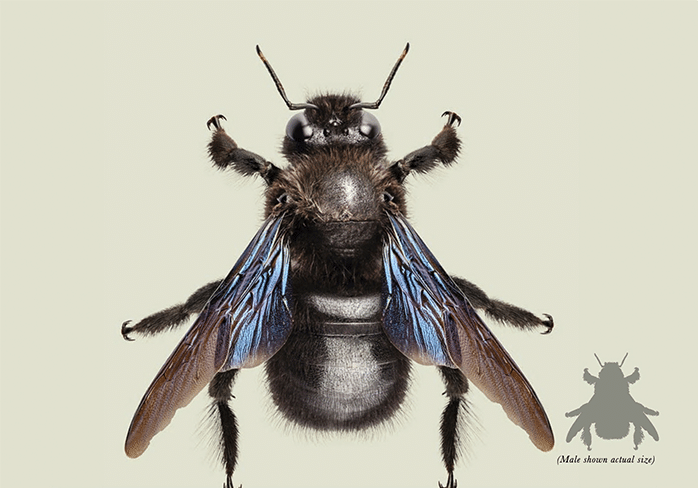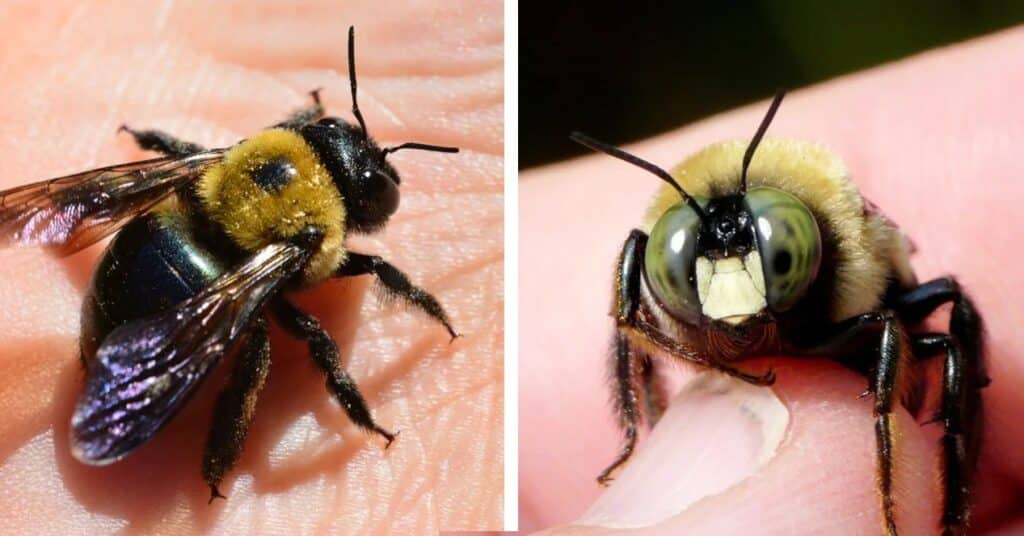Carpenter bees are a common sight in spring as these large, fuzzy bees begin excavating holes in wood to make their nests. But should we view carpenter bees as helpful pollinators or pesky home-damaging pests? The truth is, carpenter bees can be both beneficial and problematic depending on the species and location. Let’s take a closer look at the pros and cons of these misunderstood bees.
What are Carpenter Bees?
Carpenter bees resemble bumblebees in size and appearance. There are nearly 700 species of carpenter bees, belonging to the genus Xylocopa, found worldwide. In the United States, the most common species are the Eastern carpenter bee (Xylocopa virginica) and the Western carpenter bee (Xylocopa californica).
The main trait setting carpenter bees apart is their wood-boring nesting habits. Unlike bumblebees that nest underground, carpenter bees tunnel into wood to make their nests. Female bees do the excavating using their robust mandibles to chew circular holes into wood surfaces. The holes lead to a network of tunnels and chambers where the bees rear their young.
The Benefits of Carpenter Bees
So should we welcome carpenter bees or shoo them away? There are some clear benefits these bees provide
Excellent Pollinators
Like their fuzzy bumblebee cousins, carpenter bees are covered in hair that enables them to carry high volumes of pollen from flower to flower. Their large size also allows them to buzz pollinate, vibrating floral anthers to release pollen. This makes carpenter bees excellent pollinators for gardens and orchards.
Native Species
Carpenter bees are native to North America present long before human structures. They fill an important niche in local ecosystems. Supporting native bees promotes biodiversity and a healthy environment.
Docile Nature
Male carpenter bees cannot sting. Females can sting but rarely do unless handled. The bees tend to be calm unless defending nests. Their mellow temperament makes them easy to have around.
Active Pollination Period
Carpenter bees emerge early in spring when few other pollinators are active. They also remain active into fall. Their long active season is a bonus for pollination.
The Downsides of Carpenter Bees
On the other hand, carpenter bees do have some drawbacks that can make them a nuisance:
Wood Damage
Carpenter bee tunneling and nesting can damage wood structures over time. The holes weaken wooden surfaces and ruin aesthetics. The bees preferentially target unfinished softwoods but will bore into painted and treated woods too.
Resident Bees Lead to Woodpeckers
While carpenter bees alone do not destroy structures, they make way for woodpeckers to move in. Woodpeckers enlarge the holes searching for bee larvae and tunnel deeper into wood, causing extensive damage. Preventing carpenter bees reduces likelihood of woodpeckers.
Difficult to Deter
Once bees move into a favorable nesting area, they persistently return year after year. Filling holes with caulk or other materials provides only temporary solutions. Carpenter bees just drill new entry holes nearby. Pesticide sprays also have limited success.
Troublesome Males
Male carpenter bees aggressively defend territory around nests. They repeatedly dive bomb and bump humans or animals that get too close. This frightening territorial behavior can make outdoor areas unpleasant.
Encouraging Carpenter Bees in the Right Places
Carpenter bees offer important pollination services that benefit gardens and agriculture. Their nesting habits only become problematic when tunnels compromise the integrity of structures. Some ways to take advantage of carpenter bee benefits while minimizing damage include:
- Planting pollinator gardens with season-long bloom to attract and keep bees nearby
- Installing wooden nesting blocks in gardens for bees to use instead of buildings
- Allowing bees to occupy outbuildings, sheds, or fences instead of homes
- Using only hardwoods, paint, or treatments on vulnerable surfaces
- Plugging holes during bee dormancy to prevent re-use
- Applying non-toxic deterrents like essential oils near nests
With some planning, carpenter bees can be encouraged to nest in areas where their activities do good instead of harm. A hands-off approach is best to sustain these gentle native pollinators while protecting homes. If carpenter bee damage becomes severe, seek targeted control methods over broad extermination. With understanding of their behaviors, carpenter bees can be considered helpful residents rather than pests.
Carpenter bees offer valuable pollination services but their nesting habits can conflict with human structures. By providing bee-friendly spaces in gardens and allowing them to occupy non-essential structures, their benefits can be obtained without damage to homes. With some adjustments, carpenter bees can be considered “good” for both nature and humans. Their role in local ecology means finding ways to coexist sustainably should be prioritized over elimination. A closer look at carpenter bees reveals they are neither purely pests nor heroes, but complex creatures playing an important part in the web of life.
Types of carpenter bees

There are hundreds of types of carpenter bee species found all over the world, and each varies in its appearance, location, and overall behavior. For example, the Violet Carpenter Bee is a black bee with dark wings, which in bright light shine purple or blue. This carpenter bee, native to Asia, is active from February to June, raising one and sometimes two broods each year. They nest from April in deadwood, grass stems, or bamboo canes. They also nest in wooden houses and are sometimes regarded as pests (although this bee is not aggressive to humans and rarely stings).
The Eastern Carpenter Bee is a different kind of carpenter bee. It lives in most of the United States and parts of Canada. According to BestBeeBrothers. com, the Eastern Carpenter bee favors structural timbers for nesting, including pine and cedar wood. The Eastern Carpenter Bee is the most common type of carpenter bee. What makes it unique is that it can cut into the sides of flower petals to get to the nectar without pollinating them. This is how it got the name “nectar robber.” People often notice that this species of bee has jawbones that help it collect nectar better than other types of carpenter bees.
The largest bee in California is the California Carpenter Bee, which is also called the Valley Carpenter Bee. It is from western North America. This carpenter bee makes its nest by creating long, double-ended passages in the limbs of oak trees. OurCityForest. org, their nests are usually watched over and cared for by a mother bee and her unmarried daughters. The male Valley Carpenter Bee is very rarely seen.
Male vs. Female carpenter bees

A male and female carpenter bee look a lot alike, but there’s a lot more to these bees than meets the eye. One surefire way to tell them apart is by looking at their heads: the male’s will have a white spot on it, while the female’s will be black and have no signs on it.
Male and female carpenter bees also have very different jobs, too. The female carpenter bee’s only job is to build nests by drilling and burrowing through holes in wood. The male carpenter bee, on the other hand, is always on the defensive. Its main job is to protect the nest, and even though it doesn’t have a stinger, its bigger size and aggressive behavior help it keep any unwanted guests away. It’s not likely that you’ll come into contact with a female carpenter bee because she’s usually busy building the nest. But if you do, you should know that her sting can be very painful.
Chart from a-z-animals.com:
| Male Carpenter Bee | Female Carpenter Bee | |
| Head Color | Has a white spot or marking on his head. | Completely black |
| Roles and Responsibility | Defends its territory and nests | Burrows wood and makes holes to build nests |
| Stingers | Has no stingers | Has stingers on her back |
| Temperament | More aggressive | More even-tempered |
| Nectar Robbing | Responsible for most nectar robbing
Mildly destructive to flower structure when compared to females. |
Responsible for less nectar robbing compared to males
Extremely destructive to flower structure |
Carpenter Bee Facts: the WOOD BEE Animal Fact Files
FAQ
Should you remove carpenter bees?
How beneficial are carpenter bees?
Are carpenter bees bad to have around?
Can carpenter bees recognize you?
Are carpenter bees good pollinators?
“Just like other bees, carpenter bees forage for pollen and plant nectar, and serve as excellent pollinators.” Here’s what to know about carpenter bees, including what to do if they’ve taken a liking to your wooden structures. What Is a Carpenter Bee? Carpenter bees are some of the largest native bees in the U.S.
Do carpenter bees eat wood?
Carpenter bees are a source of joy when we see them peacefully buzzing among the flowers. But occasionally they can become a frustration, especially when they gnaw into our wooden homes, fences, decks and patios. “But these bees don’t actually eat the wood as food,” says Emma Grace Crumbley, an entomologist with Mosquito Squad.
Are carpenter bees a good thing?
Having carpenter bees is a very good thing, as long as they are not burrowing deep tunnels into parts of your house or other structures causing damage. Encourage them when you can, and please be gentle by using the least toxic methods possible if you can’t have them living so close to home.
How long do carpenter bees live in a house?
Carpenter bees can live for a few years, and in that time they may have no need to abandon or replace a perfectly good home. Carpenter bees prefer soft, untreated wood, but will drill into any other type if it’s all that they can find. Their favorites include oak, redwood, pine, and fir.
What is a carpenter bee?
Large carpenter bees (about 500 different species) belong to the genus Xylocopa. Interestingly, these insects inhabit every continent except Antarctica. Carpenter bees get their name from their woodworking skills. These solitary bees excavate nest tunnels in wood, especially in lumber that is bare and weathered.
Are carpenter bees attracted to wood?
Carpenter bees are attracted to certain factors in their environment. Here are the main attractants for these bees: Untreated Wood: Carpenter bees prefer bare, unpainted, or weathered softwoods. They are especially attracted to softwoods like pine, cedar, redwood, and cypress. These are their preferred nesting materials.
